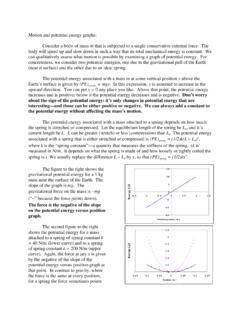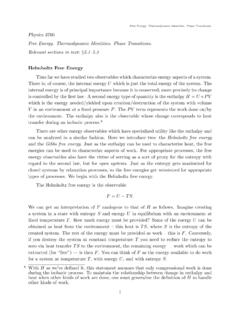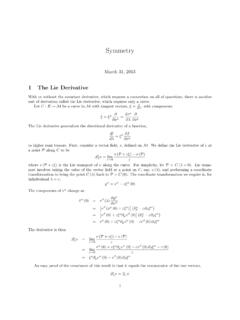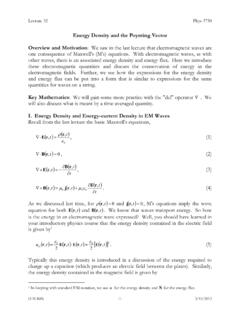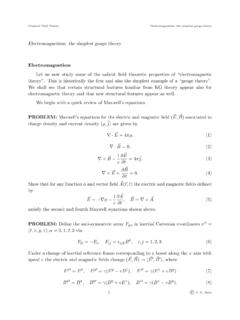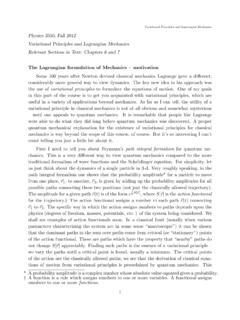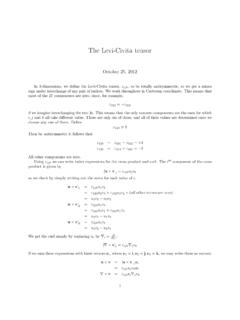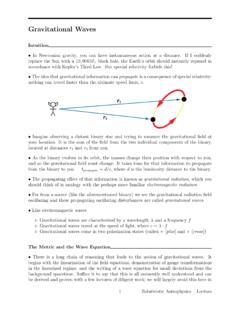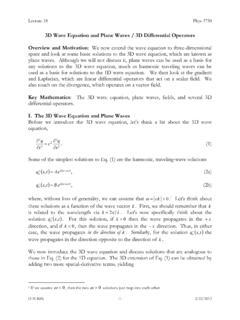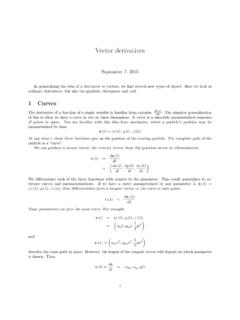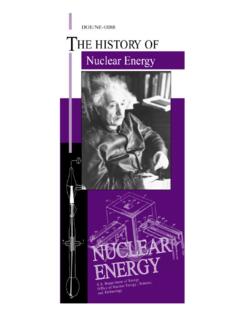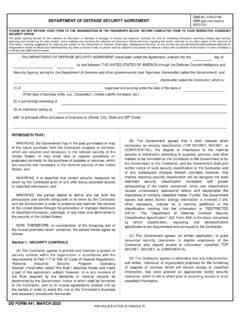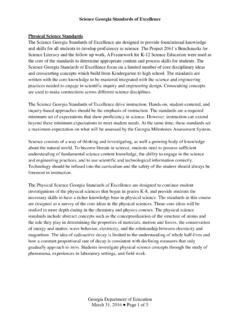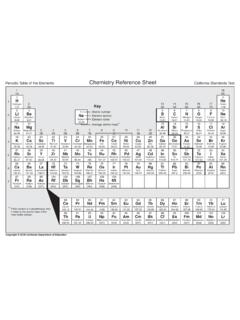Transcription of Microstates and Macrostates - Physics Department
1 Microstates and Macrostates . Multiplicities. The Second Law. Physics 3700. Microstates and Macrostates . Multiplicities. The Second Law. Relevant sections in text: Microstates and Macrostates What is thermal equilibrium? What is temperature? Why does heat transfer energy from higher to lower temperatures? One cannot get very far with such questions in tra- ditional thermodynamics because thermal equilibrium, heat and temperature are more or less defined via the laws of thermodynamics. We have introduced the concepts of tempera- ture and heat via the zeroth and first laws. Our next subject will be the second law, which characterizes (among other things) heat transfer of energy and relaxation to equilibrium. To understand the origins and meaning of the second law it is instructive to take a pretty general look at the microscopic statistical behavior of a macroscopic system.
2 This leads to a number of payoffs: a better understanding of the idea of temperature and heat, plus a new, very profound observable: the entropy.* This is what we will do now. By analyzing the microscopic structure of systems to understand their thermodynamic behavior, we are going beyond traditional thermodynamics. The realm we are entering is sometimes called statistical thermodynamics. We first introduce the very fundamental statistical ideas of Microstates and Macrostates . Given a system ( , a gas), we view it as built from some elementary constituents, ( , molecules). Each constituent has a set of possible states it can be in. The thermodynamic state of the system (which characterizes the values of macroscopic observables such as energy , pressure, volume, etc.)
3 Corresponds to many possible states of the constituents (the molecules). The collection of states of all the constituents is the microstate. To keep things clear, we refer to the macroscopic, thermodynamic state as the macrostate. The vast disparity between the number of possible Macrostates versus Microstates is at the heart of thermodynamic behavior! The number of distinct Microstates giving the same macrostate is called the multiplicity of the macrostate. The multiplicity is a sort of micro- scopic observable which can be assigned to a macrostate. Here's an elementary example. Consider what happens when you roll a pair of dice. Think of the 2 dice together as playing the role of the macroscopic system, and let the individual dice play the role of the microscopic constituents.
4 Then the two individual dice values be the microstate and the total value of the dice roll defines the macrostate. There * The entropy can be defined as a thermodynamic observable with no reference to an un- derlying statistical model, but it is much more instructive to derive it from microscopic considerations. 1. Microstates and Macrostates . Multiplicities. The Second Law. are 11 Macrostates : (2, 3, 4, .. , 11, 12). Let us compute the multiplicities of each of these macrostate. We display them as pairs: (macrostate, multiplicity) =. (2, 1), (3, 2), (4, 3), (5, 4), (6, 5), (7, 6), (8, 5), (9, 4), (10, 3), (11, 2), (12, 1). By the way, you can see the relative probabilities for various dice rolls here, assuming that each microstate is equally likely. For example, it is 6/2 = 3 times more likely to roll a seven than to roll a 3.
5 To get the actual probabilities of a given macrostate you have to figure out the probability for an individual microstate always 1/36 in the dice example then multiply by the multiplicity.* So, for example, the probability of rolling a 4 is 3/36 = 1/12. (Note that the mulitiplicities add up to 36, so that the probability for getting anything between 2 and 12 is 1/36 + 2/36 + + 1/36 = 1.). In the dice example, there were 2 constituents and each constituent had 6 possible states, leading to 6 6 = 62 = 36 possible Microstates . Macroscopic systems have many constituents so we should explore what happens when there are many constituents. If there are N constituents, and each has p states, then there are pN possible Microstates . This number can be enormous. Already for 2 dice we had 36 Microstates .
6 The number of Macrostates is smaller much smaller for large N than the number of Microstates . For the dice we had 11 Macrostates . For three dice we have 63 = 216 Microstates and 16. Macrostates . As another example, suppose you had N coins. These are the constituents of your system and each has two possible states: heads (H) and tails (T). There are 2N possible Microstates . If a macrostate is specified by the number of heads and tails, how many Macrostates are there? Well, first of all, you must note that if there are NH heads, then there will be N NH tails, so we only need to see how many possible values there are for NH . This is N +1, as you can easily see. What are the multiplicities of these Macrostates ? How many ways can you arrange NH heads among N coins? We are trying to pick NH.
7 Coins to be heads out of N total coins how many ways to choose NH objects out of N. objects? This is a fundamental question from combinatorics. The answer is given by the N. binomial coefficient NH . n . In case you don't know this or recall it, the binomial coefficient m , spoken of as n choose m , is given by (with n m): n n! = . m m!(n m)! * Equivalently, divide the multiplicity by the total number of Microstates . By the way, if you view this macroscopic system as having only the two observables, NH. and NT , then the dimensionality of the system is unity, since measuring either of the observables determines the (macro)state. 2. Microstates and Macrostates . Multiplicities. The Second Law. This is the number of distinct ways of choosing m objects from a collection of n objects.
8 (Note that this formula passes some simple sanity checks: When m = n, we have n . n = 1;. n . when m = 1 we get 1 = n. Try some other simple examples.) The binomial coefficient can often be used to compute multiplicities - you just have to find a way to formulate the counting problem as choosing m objects from n objects. Sometimes this takes some ingenuity. Anyway, the multiplicity of a macrostate of N coins with NH heads and NT = N NH. tails is given by . N N! N! = = . NH NH !(N NH )! NH !NT ! Since the total number of Microstates is 2N we see that the probability P (NH ) for getting NH heads is N! P (NH ) = 2 N . NH !NT ! Quantum Paramagnet This same sort of counting can be used to compute the multiplicities of Macrostates in an elementary (quantum!) model of a paramagnet.
9 We can view the paramagnet as N magnetic moments each of which can be in 2 states either pointing parallel or anti- parallel to some given axis (determined, , by an applied magnetic field). These states are referred to as up and down , respectively. The total magnetization M along the given axis of the paramagnet is then proportional to the difference Nup Ndown = 2 Nup N . Evidently, the macrostate specified by M has multiplicity given by the number of ways of choosing Nup magnetic moments to be up out of a total of N magnetic moments. We have . N. = . Nup Paramagnetism is like coin tosses! Einstein Solid As a last, but important, example of Microstates , Macrostates and multiplicities, let us consider the Einstein model for a solid. We will use this simple model to make our first attack on the microscopic meaning of temperature and heat.
10 The Einstein model of a solid will, like the ideal gas, be a standard example for many subsequent ideas. The model amounts to viewing a solid as a collection of identical three-dimensional oscillators. Each three-dimensional oscillator can be viewed as 3 one-dimensional oscilla- 3. Microstates and Macrostates . Multiplicities. The Second Law. tors. Thus the Einstein solid can be viewed as having N constituents, each of which is a 1-d oscillator (so the number of 3-d oscillators atoms is N/3.)*. As you may recall, quantum mechanical oscillators in one-dimension have energies (n + 21 )h , n = 0, 1, 2, .., where is the natural angular frequency of the oscillator. Note the difference in energies between adjacent states is always the same, h . Evidently, the (macroscopic) internal energy U ranges from the ground state energy N2 h (the zero point energy ) to arbitrarily large values.
